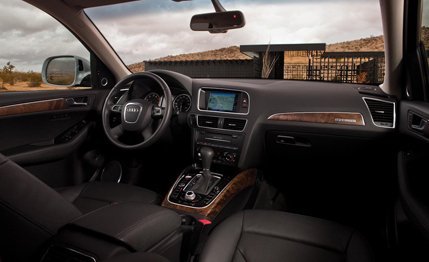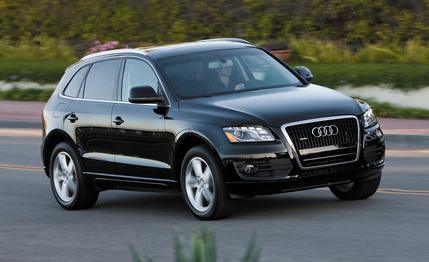
 Short Take Road Test
Short Take Road Test


Although nearly every automaker has talked big about downsizing—in essence, replacing larger engines with smaller-displacement, forced-induction powerplants to deliver similar performance and allegedly better fuel economy—Audi is among the few really going all-in with the strategy. Among the German company’s recent moves: dropping the V-6 options from its A3, TT, and A4 and installing a supercharged six in the latest S4 rather than carrying over the previous model’s honkin’ V-8. Now, for 2011, the Q5 crossover is available with the company’s excellent 211-hp, 2.0-liter turbocharged four. The 270-hp, 3.2-liter V-6 will continue to be offered for at least the next couple of years, but Audi tells us that it expects some 60 percent of Q5 buyers to stick with the base four.
Those customers won’t give up much in the way of real-world performance. The test sheet reveals that the four-cylinder is a mere 0.5 second behind the V-6 in the sprint to 60 mph and 0.4 behind in the quarter-mile, at 7.0 and 15.5 seconds. Yes, the 3.2 blasts past 100 and 120 mph 2.5 and 7.6 seconds more quickly, but nowhere in the U.S. are such speeds relevant—and who’s gonna drop the hammer all the way to triple digits in a compact luxe-UV often enough to care? Beyond the engine room, the Q5 2.0T marginally improves on the 3.2’s 70-to-0-mph braking and impressive skidpad numbers, likely due to its 250-pound weight advantage over the V-6 model.
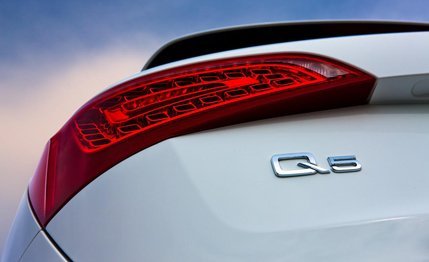

Downsizing Fuel Economy, Too?
Contrary to the downsizing hype, however, Q5 2.0T buyers may end up with no real mpg benefit compared with the V-6, especially if their right feet are as heavy as ours. Although the respective EPA ratings for the four and V-6 are 20/27 mpg and 18/23, we got only 19 mpg with the 2.0T versus 21 with the 3.2. The cold weather during our 2.0T test surely affected our number, as did our tendency to lean on the gas pedal during the couple of beats it takes for the turbo to spool. We’ve seen similarly deflated real-world fuel economy from Ford’s EcoBoost V-6, and this test provides further evidence that the power and efficiency claims of engine downsizing are generally realized exclusive of each other.
Great to Drive, Nifty Eight-Speed Auto
But if the fuel economy fails to impress, the rest of the Q5 experience does not. As we’ve already mentioned, the 2.0T’s acceleration is more than acceptable. The brakes offer good feel, as does the steering. The Q5 turns in with eagerness and never complains when you feel like hustling, with any understeer easily sorted out by a touch less throttle and the Quattro all-wheel-drive system. The ride is firm but never harsh—our kind of setup. The interior is a triumph of material selection, aesthetics, and build quality, and the front seats are supremely comfortable. Our only complaint is that the steering is a touch too slow just off-center.
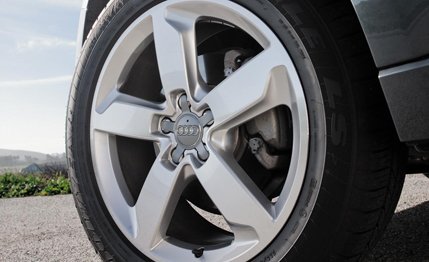

Like the 2.0-liter turbo four, the eight-speed automatic transmission also is new to the Q5 for 2011. It’s the same basic box of gears found in the BMW 7-series, Rolls-Royce Ghost, and Audi A8 and A5, among others. It upshifts with a swiftness and confidence that remind of Audi’s S tronic dual-clutch automatic, particularly with the throttle matted. Nonsequential up- or downshifts—even eight to two—can be executed manually, although you have to be a little deliberate about it, with more of a whap whap whap than a whapwhapwhap.
Functionally, the Q5 is a dandy, with 29.1 cubic feet of storage behind the rear seats. With those seats folded, which can be accomplished with a single touch, the Q5 can swallow 57.3 cubes; it could take a few more if the second row folded completely flat, but at least the seats can be locked down. The cargo floor’s height makes loading items easy—although it’s not yet as manageable as a station wagon’s—and there’s a handy storage bin below the cargo floor.
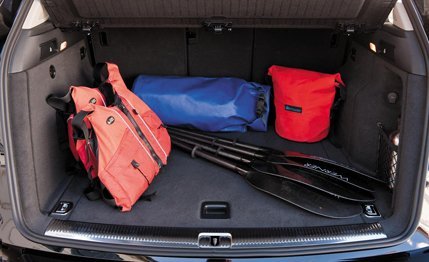

Our Q5 was a lightly optioned example, and we didn’t really miss any of the high-end zooty stuff like navigation or the unnecessary Audi “drive select” chassis-adjustment system. The add-ons totaled $1925 and included $475 paint, a $700 Bluetooth and HomeLink package, $450 heated front seats, and a $300 iPod interface. The as-tested price was an even $38,000, which is pretty reasonable for the segment, especially when you consider that the Q5 and many of its competitors can stray well into the $50,000s with all the fixin’s.
Best Rival: Audi’s Own A4 Avant
Downsizing to the 2.0T makes sense in the Q5, given its comparable performance to the 3.2-liter V-6, but if it were our money, we might be tempted to downsize again—by an entire vehicle class. Indeed, although this Audi has many impressive rivals—the best are BMW’s X3, which has been redesigned since placing second to the Q5 3.2 in a seven-vehicle comparo, and Volvo’s XC60—perhaps the best argument against the 2.0T sits across the showroom floor in the A4 Avant, which uses the same engine to better effect. The Q5 is a very good vehicle, and it makes sense if you need a higher seating position, a burlier aesthetic, more ground clearance, and a few extra cubes of storage capacity, but spring for the wagon, which costs but $700 more, and you’ll enjoy not only more handsome sheetmetal but also quicker acceleration and even more athletic reflexes. That’s the sort of downsizing we can really get behind.
